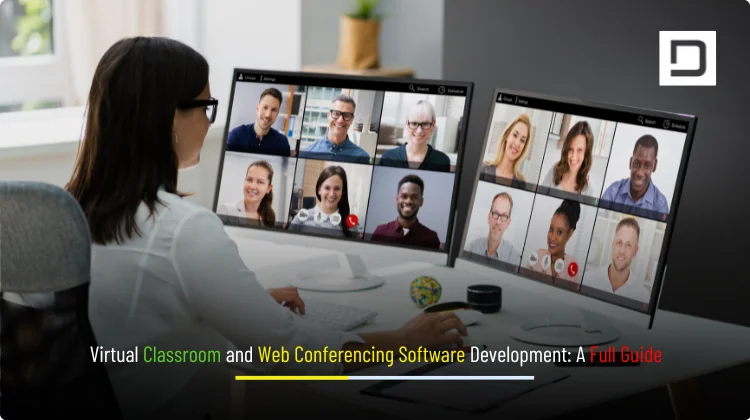Virtual Classroom and Web Conferencing Software Development: A Full Guide
Virtual learning is no longer a temporary fix. It is now part of how enterprises train teams, universities deliver accredited programs, and educators collaborate across borders. If you plan to launch your own platform, the right approach to Web Conferencing software development will decide whether your product scales gracefully, earns trust, and produces measurable learning outcomes. This full guide walks through product strategy, architecture, security, compliance, accessibility, analytics, and a realistic roadmap. It also explains how Depex Technologies helps product leaders deliver a robust virtual classroom that is AI ready and search friendly for both traditional engines and AI-first assistants.
Why build a virtual classroom now
The market keeps expanding as organizations move from ad hoc video calls to structured learning experiences that combine live sessions, interactive activities, and asynchronous study. Learners want reliability, zero friction, and the feeling of presence. Instructors want moderation controls, content workflows, and proof of learning. Administrators want governance, privacy, and total cost transparency. Investing in a focused platform gives you the control to meet these groups where they are while protecting data and brand reputation.
From a product standpoint, owning the experience also unlocks deeper integrations with your business systems. You can connect HR platforms for attendance, pull CRM context into sales enablement training, or push assessment scores into your data warehouse. A purpose built approach to Web Conferencing software development will let you innovate quickly and personalize without fighting the constraints of generic tools.
What makes a virtual classroom different from basic video calling
A virtual classroom centers on instruction and outcomes, not only communication. The platform combines conferencing with pedagogy, content management, analytics, and governance. These differences drive your functional and technical requirements.
- Live learning needs tools such as breakout rooms, quizzes, polls, whiteboards, and hand raising.
- Instructors require fine grained roles, proctoring workflows, and session templates.
- Students benefit from guided navigation, transcripts, captions, and learning paths tied to assessments.
- Program managers need audit trails, certificate management, and reporting across cohorts.
Treat these differences as core, not add ons, otherwise adoption will plateau.
Core capabilities to include from day one
You can phase features, yet certain pillars need to be ready at launch. Instead of listing an exhaustive set, let us connect each pillar to the outcome it supports.
1) Low latency audio and video
Learners participate when the experience feels natural. To achieve this, prioritize media quality, efficient bandwidth adaptation, and seamless device switching. Choose a real time communications layer designed for variable networks. Favor standards based streaming with adaptive codecs and smart congestion control. Plan for a global relay network or selective forwarding units to reduce round trips.
2) Classroom facilitation
Teaching live calls for structure. Provide host controls for muting, spotlighting, and admitting attendees. Add a queue to manage questions. Offer breakout sessions that preserve context and record attendance. Enable session templates so instructors configure once and reuse.
3) Content and collaboration
Students learn by doing. Build an embedded whiteboard, time stamped chat, and moderated Q and A. Support file sharing that is audited. Allow instructors to drop interactive elements into the timeline. Include a lightweight presentation mode that takes slides, PDFs, and clips. Couple this with notes that map to points in the recording.
4) Assessment and feedback
Learning outcomes must be measurable. Provide short quizzes during and after the session. Capture sentiment with quick polls. Attach rubrics to assignments. Export results to a gradebook, an LMS, or a data warehouse. Show instructors trend lines across cohorts and topics.
5) Recording and knowledge reuse
A strong recording workflow turns one event into persistent knowledge. Offer cloud recording with auto chaptering. Generate transcripts and captions. Extract key moments and action items. Store content with access controls and expirations that satisfy policy. Make recordings searchable by topic, speaker, and intent.
6) Accessibility
Accessibility is not optional. Ship live captions, keyboard navigation, screen reader support, adjustable contrast, and sign language layout modes. Provide transcription in multiple languages and allow custom glossaries for technical terms. Include descriptive labels on all controls and thorough focus management.
7) Security and compliance
Trust is a prerequisite for adoption. Build identity, authorization, encryption, data residency, and audit logging into your foundation. Plan for role based access with fine grained permissions. Secure recordings at rest with modern encryption. Provide meeting lobby and waiting room controls. Align with standards that your customers require, such as SOC 2, ISO 27001, and GDPR. Add retention policies and export tools for data subject requests.
8) Admin governance and observability
Organizations need control. Give admins policy templates, domain restrictions, SSO, SCIM provisioning, and session analytics. Provide real time health dashboards that surface packet loss, CPU spikes, and device issues. Offer a trust center with a clear view of uptime, incidents, and compliance reports.
Architecture blueprint
An opinionated architecture will shorten time to market and reduce risk. The blueprint below focuses on proven patterns for Web Conferencing software development while leaving room for innovation.
Signaling and session orchestration
Use a dedicated signaling service to establish peer connections, exchange session descriptions, and manage participant state. Keep it stateless behind a load balancer. Persist meeting metadata and policies in a relational store. Cache active room state in memory for fast lookups and recovery. Consider event streaming for clean decoupling between signaling and analytics.
Media servers and routing
For small sessions with a handful of participants, peer to peer can work. For classrooms and webinars, a selective forwarding unit solves scaling and device diversity. An SFU receives streams and forwards them to others with minimal processing. This design supports simulcast, spatial audio, and layer selection. Use regional SFUs close to users with health based failover.
Recording and post processing
Cloud recording works best when the media pipeline writes both raw and composed variants. The raw track archive enables future edits and AI processing. The composed version creates an instant playback file. A media worker pool can transcode, generate thumbnails, and push assets to an object store with lifecycle policies.
Real time data channels
Interactive features need low latency data. Use reliable data channels for chat, reactions, and control messages. For quizzes and polls, send ephemeral state through the same channel and persist the result in your database. Keep payloads small and schema versioned.
Identity, auth, and roles
Support SSO providers, passwordless email links, and magic codes. Map users to organizations and roles such as super admin, instructor, moderator, student, and guest. Policies should define who can create rooms, record, download files, or share links. Treat instructor elevation as a controlled operation with audit trails.
APIs and integration layer
Design a public API so customers can schedule sessions, fetch recordings, or sync rosters. Document webhooks for events like session started, participant joined, quiz completed, and recording available. Provide SDKs for JavaScript, iOS, and Android. Offer a thin LMS connector to work with common platforms through learning tool standards and SSO.
Observability
Instrument everything. Emit metrics for join time, media start time, speaking time, bitrate, and CPU usage by device. Attach logs to session IDs and user IDs with PII controls. Export to your telemetry platform for dashboards and alerts. Correlate client logs with server metrics to debug issues fast.
AI features that actually help learners
AI is only valuable when it improves outcomes or reduces toil. Here are practical features to consider when you shape your roadmap.
- Live summaries and action items: While a session runs, generate a rolling summary to help late joiners catch up. After the session, provide a structured outline with action items and links to chapters.
- Content search and retrieval: Index transcripts, slides, whiteboard strokes, and chat. Let users ask questions and jump straight to the relevant moment in the recording.
- Proactive quality assistance: Alert hosts when a participant has muted audio or when network conditions degrade. Suggest turning off background processes on devices that report high CPU usage.
- Assessment assistance: Draft quiz questions from uploaded slides. Suggest rubric criteria for open ended assignments. Always keep a human in the loop for accuracy and fairness.
- Accessibility enhancement: Improve caption accuracy through custom vocabularies. Offer multi language dubbing and speaker naming.
These features should respect privacy, honor opt in preferences, and store only the minimal data required for the task.
Designing for scale and reliability
A single peak day can ruin a reputation. Design for bursts, upgrades, and graceful degradation.
- Capacity planning: Model daily and weekly seasonality. Keep headroom across signaling, media, and storage layers. Prepare cold standby capacity for events like assessments or corporate town halls.
- Global distribution: Place SFUs and edge nodes near your user clusters. Route with latency aware and health aware policies.
- Resilience: Isolate failures with circuit breakers. Fall back to audio only when bandwidth is constrained. Provide network handoff so users can switch from Wi Fi to mobile data without dropping the session.
- Zero downtime deploys: Use blue green or canary releases. Test backward compatibility in signaling and data schemas.
A platform that stays up during exams and critical training builds long term trust.

Security and privacy practices to adopt early
Security that is an afterthought becomes expensive. Embed the following into your delivery process.
- End to end encryption options: Provide room level choices for sensitive sessions. Communicate tradeoffs clearly so admins select the right level.
- Key management: Segregate keys by tenant and region. Rotate keys automatically.
- Least privilege access: Limit service roles and use short lived credentials.
- Secure media links: Time bound URLs for recordings and attachments.
- Data minimization: Only store what you must. Anonymize analytics when possible.
- Third party risk: Vet dependencies for licensing, maintenance, and security posture.
- Incident response: Run tabletop exercises. Publish a clear vulnerability disclosure policy.
These steps reduce risk and accelerate enterprise deals.
Compliance alignment
Enterprise and education customers evaluate compliance in detail. Plan for these items.
- SOC 2 and ISO 27001: Formalize your controls and audits.
- GDPR and data residency: Provide regional storage and data export capabilities.
- FERPA or equivalent education privacy: Restrict access to student records and protect transcripts.
- Accessibility standards: Align with WCAG guidelines and document conformance.
Compliance is not only checkboxes. It protects learners and institutions while unlocking larger contracts.
Product analytics that matter
Dashboards should drive decisions, not vanity reporting. Focus on metrics that reflect learning and reliability.
- Experience metrics: Join time, rebuffer rate, audio dropouts, frame rate stability, and average speaking time per participant.
- Engagement metrics: Poll participation, chat messages, hand raises, breakout attendance, and assignment submission rates.
- Outcome metrics: Quiz scores over time, certification completion, content reuse, and session replay minutes.
- Operational metrics: Peak concurrent users, average session size, and support tickets per thousand learners.
Feed these signals into your roadmap, growth loops, and customer success playbooks.
Pricing and monetization models
Platform economics vary by audience and value proposition. Choose a model that aligns with how customers buy training and education.
- Per host or per instructor: Simple for small teams and bootcamps.
- Per active learner or per minute: Better for large institutions that scale up during semesters.
- Add ons: Offer transcription bundles, compliance packs, or advanced analytics.
- Enterprise agreements: Combine platform licenses with professional services, onboarding, and premium support.
Provide clear calculators and caps to build trust with procurement teams.
Build versus buy considerations
Many teams ask whether they should integrate a video SDK or build every component. A hybrid strategy usually wins.
- Buy the heavy lifting for real time media: Use mature RTC infrastructure and SFUs so you do not reinvent transport logic.
- Build differentiated workflows: Own classroom facilitation, assessment logic, reporting, and your AI features.
- Keep an escape hatch: Abstract the media layer behind an interface so you can switch providers if costs or features change.
This approach reduces time to market while preserving long term control.
A pragmatic delivery roadmap
A strong roadmap ties scope to measurable outcomes. Below is a sample plan that many teams adopt with Depex Technologies.
Phase 0: Discovery and architecture
Interview instructors, admins, and students. Map compliance requirements. Define success metrics such as join time under ten seconds, attendance accuracy within one percent, and quiz completion above eighty percent. Produce UX flows, data models, and a capacity plan. Choose a tech stack, vendors, and hosting regions.
Phase 1: Minimum lovable classroom
Deliver the core: account creation with SSO, session scheduling, live audio and video with screen share, chat, hand raise, basic breakout rooms, and cloud recording. Ship captions and keyboard navigation from day one. Build observability and admin controls in parallel. Release to a pilot cohort and watch engagement and reliability metrics closely.
Phase 2: Assessment and knowledge reuse
Add quizzes, polls, rubrics, assignments, and a searchable recording library with auto chapters. Introduce AI assisted notes and summaries with opt in controls. Expand admin governance with retention policies and domain restrictions.
Phase 3: Scale and compliance
Roll out regional media nodes, improved bandwidth adaptation, and proactive quality alerts. Complete SOC 2 and align with GDPR data export. Add certificate management and gradebook integrations.
Phase 4: Personalization and growth
Introduce learning paths that weave live and asynchronous content. Add recommendation models that respect privacy. Expand analytics for cohort trends. Launch pricing tiers and enterprise agreements.
This sequence avoids scope creep while keeping momentum visible to stakeholders.
Tech stack suggestions
The exact stack depends on your team skills and constraints, still these choices are proven.
- Front end: React or Vue for the web app, Swift or Kotlin for native mobile, and a shared design system.
- Real time layer: A battle tested WebRTC stack with SFU support, TURN servers for NAT traversal, and regional routing.
- Back end: Service oriented architecture with Node.js, Go, or Java. Use a relational database for core metadata and a columnar store for analytics.
- Storage: Object storage for recordings, slides, and whiteboards. Apply lifecycle rules and encryption at rest.
- Search: Full text search over transcripts and chat with custom analyzers for names and course codes.
- Infrastructure: Containers and orchestration with autoscaling, IaC for repeatable environments, and a CDN for assets.
- Testing: Unit tests, integration tests with headless browsers, and synthetic join tests that run every few minutes across regions.
Depex will tailor the stack to your requirements, taking into account team skills, compliance needs, and planned scale.
Quality assurance that mirrors real classrooms
Traditional test plans miss the nuance of live instruction. Simulate real conditions.
- Test audio with multiple microphones and noise profiles.
- Validate captions for accuracy on domain terms.
- Push low bandwidth scenarios to confirm graceful fallbacks.
- Run long sessions to observe drift, CPU creep, and memory use.
- Verify accessibility with keyboard only navigation and screen readers.
- Record and replay to validate chaptering and transcript search.
Tie each test to a user risk and a product metric so quality work remains focused.
Making the platform AI first and search friendly
Modern discovery happens through both classic search engines and AI assistants. Design your content and endpoints to be crawlable and helpful.
- Generate clean, structured pages for session summaries, recordings, and resources with schema markup.
- Provide public knowledge pages when appropriate with opt in.
- Produce descriptive titles, headings, and internal links for chapters and highlights.
- Expose a developer friendly API that agents can query with user consent to surface the right moments from recorded sessions.
- Keep transcripts accurate through custom dictionaries and speaker labels.
This approach improves findability, which in turn increases the value of your content and the time learners spend in your platform.
Total cost of ownership
Budgeting for Web Conferencing software development requires a realistic view beyond initial sprints.
- Build cost: Product, design, engineering, and QA for the first release.
- Media and bandwidth: Variable costs driven by minutes, bitrate, and regions.
- Storage and processing: Recording, transcription, and AI workloads.
- Compliance and security: Audits, tooling, and staff time.
- Support: Tiered support and incident handling.
- Roadmap: Continuous investment in features and performance.
Depex models these costs with you and proposes optimizations such as codec choices, adaptive recording, and intelligent caching.
Common pitfalls and how to avoid them
Teams often stumble in similar ways. Awareness helps you steer clear.
- Overreliance on a single region: Users far from the media node suffer. Plan for geographic distribution early.
- Ignoring accessibility until later: Retrofits are costly and slow. Build it in from the start.
- Underspecified analytics: Without real metrics, you cannot diagnose poor sessions or improve engagement.
- Weak admin tooling: Instructors become de facto support. Strong admin controls prevent chaos.
- Opaque pricing: Surprise bills damage trust. Offer alerts and caps.
A steady cadence of usability tests and production telemetry keeps the product aligned with real needs.
How Depex Technologies delivers
At Depex, delivery is anchored in outcomes, security, and flexibility. We connect every feature to a measurable metric, from join time to quiz completion. Automated tests, secure coding checks, and review gates are part of every project. Engagement models can be tailored to your situation, whether you need a discovery sprint, a dedicated team, or a fixed scope pilot. You will always see evidence of quality and progress.
Our teams have shipped platforms where classrooms run across time zones, recordings are processed into reusable micro lessons, and admins govern access confidently. We bring a proven blueprint for Web Conferencing software development, an emphasis on accessibility, and a focus on privacy that enterprise buyers expect.
Conclusion and next steps
Learners deserve clarity, interactivity, and reliable access. Instructors deserve tools that keep attention on teaching. Administrators deserve governance and visibility. The right platform balances all three. With a thoughtful roadmap, an architecture built for scale, and security as a foundation, you can launch a virtual classroom that grows with your organization and delivers real outcomes.

If you are ready to evaluate your current stack, choose the right standards, and design an AI ready rollout that fits your budget and timeline, Depex Technologies can help. Our team will align features with your learning goals, reduce risk with strong governance, and accelerate delivery with a tested blueprint. Contact Depex Technologies today to start your Web Conferencing software development project and turn live sessions into lasting learning value.






